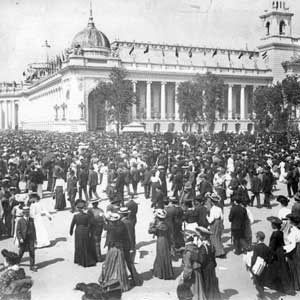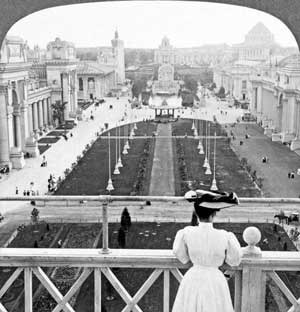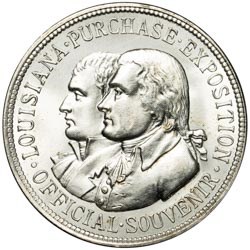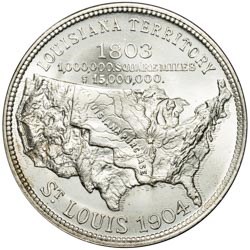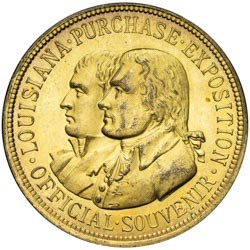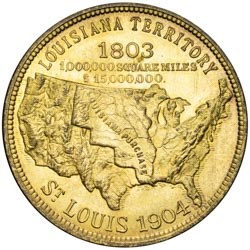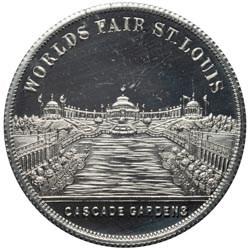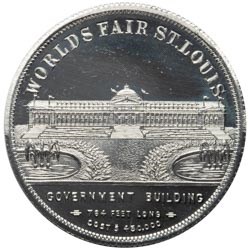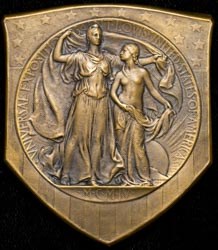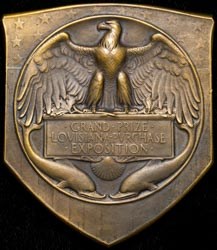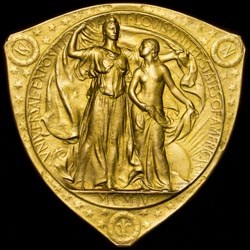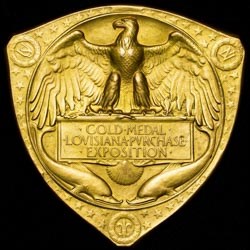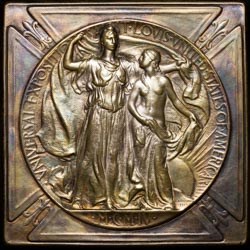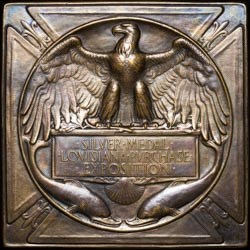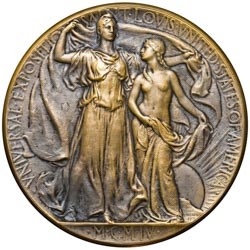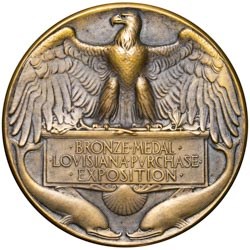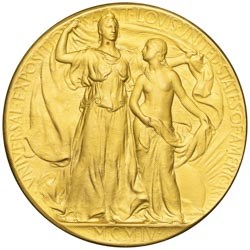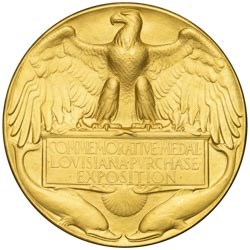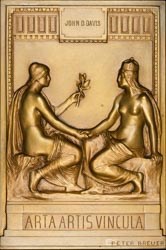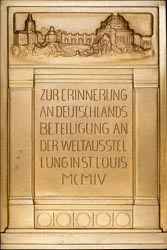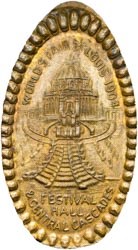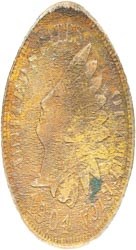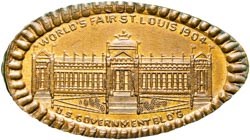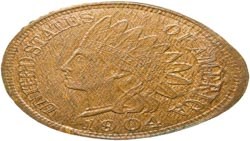The Louisiana Purchase Exposition and Medallic Souvenirs
Posted on 12/10/2019
The Louisiana Purchase Exposition, also known as the St. Louis World’s Fair was held in 1904 to commemorate the 100th anniversary of the purchase of the Louisiana Territory from Napoleon’s France. With this transaction, Thomas Jefferson doubled the size of the United States at the time, and for only $15 million, which is less than 3 cents per acre. This purchase is considered “second in importance to the nation’s development only to the American Revolution.” Jefferson, on the council of his Cabinet, had to accept that a Constitutional Amendment was not necessary for the purchase, and later quipped: “it is the case of a guardian, investing the money of his ward in purchasing an important adjacent territory and saying to him when of age, I did this for your good.” Parts of 15 states would be carved from the real estate gained.
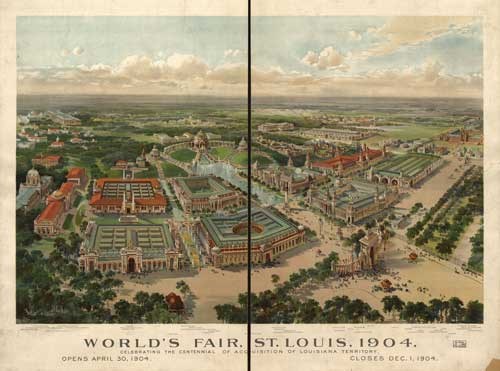 |
|
|
A Birdseye view of the Louisiana Purchase Expo fairgrounds. Click images to enlarge. |
|
A celebration of the centennial of this event was well-justified, and what better place than the central location of St. Louis—inside the boarder of the Louisiana Territory. Plans were so grand, that the fair had to be delayed a year until April, 1904 to allow construction and setup to be completed. The fair was built on a 1,200 acre site on which 1,500 buildings were installed, connected by 75 miles of roads and sidewalks. Fifteen major exhibition palaces boasted landscaping lagoons, gardens, fountains and sculptures on the exterior with sometimes thousands of exhibits inside. These all spewed in a fan-like pattern from the massive Festival Hall which featured the Cascade gardens that flowed into the Grand Basin. The fair’s concept was so large that it was impossible to give even a hurried glance at all of the exhibits and paraphernalia in less than a week. Exhibits were set up for about 50 foreign countries and 43 (of the then 45) states. In all, the expo was experienced by nearly 20 million people.
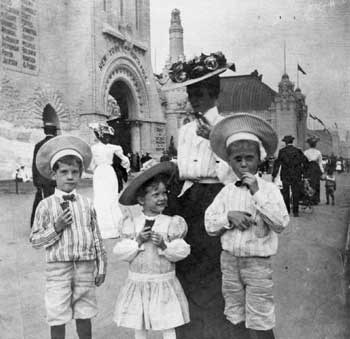 |
|
| A woman and her children enjoy ice cream cones at the 1904 World's Fair. |
|
Visitors travelled from all over to bask in the bliss of all the joys the fair had to offer. From lush gardens and landscapes, to concerts, contests, and theaters. By the turn of the 20th century, America was already living in the future of agriculture. New research in cultivation, gas-powered tractors, and new machinery made food easier to produce, and more plentiful than ever. Those who set up food booths and dainty shops wanted to impress visitors with the latest and greatest art and newly concocted flavors. There were palaces of sweet corn, butter sculptures, and animals made from fruit. One vender, the Syrian Ernest Hamwi, introduced a crisp, waffle-like cone, or cornucopia, when the booth next door offering ice cream ran out of bowls. St. Louis residents will tell you this is where the ice cream cone was born, but a man in New York had already patented the idea a year earlier, in 1903. Regardless, the crowds were surrounded by hundreds of novel options, and they lined up in a flurry to try them all.
While traveling to the fair may have been perilous for some, the fair itself was quite a safe environment. Gas lights covered the fairgrounds, illuminating the streets. Gambling was hindered so that even the up-and-coming sport—Cuban Jai Alai—was banned to prevent bets being placed during competitions. Eric P. Newman, the great numismatist, historian and author wrote, “my mother was arrested for driving her 2-cylinder Rambler auto at 21 miles per hour in Forest Park.” Security was run by a division called the “Jefferson Guards” who consisted of war veterans from the Spanish and Philippine-American wars. Visitors could be arrested for walking on the grass or carrying lit cigars into the exhibit buildings (which were constructed of wood). A total of 1,160 lost children were delivered to The Model playground, where parents could pick them up. Additionally, Scotland Yard agents, present to protect the exhibit of Queen Victoria’s jubilee treasures, were headed by Sir John Kenneth Ferrier, who demonstrated a new crime solving technique: fingerprinting.
Souvenirs were plentiful, and allowed every visitor to take a memento home with them. They represent a rare peaceful time in American history and happy memories from the fair. These include decorative plates, photographs, fans, spoons, pins, jewelry, post cards, ribbons, awards, sewing boxes, trays, watches, and so much more. Many of the items sold at the fair are now traded and sold among antique enthusiasts. The helpful reference “1904, St. Louis World’s Fair Mementos and Memorabilia” by Robert L. Hendershott has been the standard for identifying, categorizing and valuing these items. The book also features medallic items NGC certifies, including tokens, medals, encased cents, elongated cents, fobs, plaques, and punch tags. A selection of these items are featured below.
The official medals were struck in the US Mint Exhibit on the fairgrounds. They were struck in silver, copper, bronze, and gilt, with a single medal struck in gold. The silver medals sold for $1, and later $1.25, while the bronze sold for 25 cents, and the gilt-bronze for 50 cents.
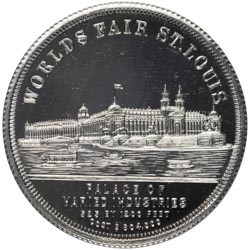 |
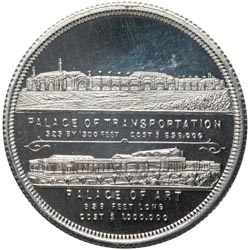 |
| HK-316 & HK-321: A well-executed series of medals was produced featuring the exposition buildings. They were struck in brass and aluminum and have proof-like surfaces. Click images to enlarge |
|
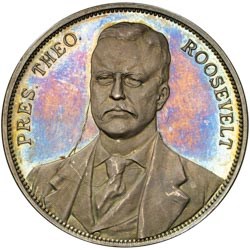 |
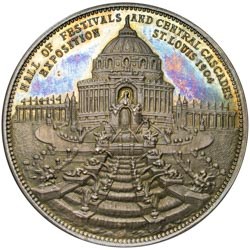 |
| HK-308: A rare silver medal featuring President Roosevelt and the Festival Hall and Cascade Gardens. Graded NGC PF 64. Click images to enlarge |
|
The Exhibit Award Medals, had unique shapes but common center designs. They were designed by Adolph A. Weinman and struck at the US Mint in Philadelphia. The awards were presented to the exhibiters, along with a diploma, rather than having engravings done on the medals themselves. The obverse of the medal depicts Columbia (on the left) with her arms spread wide holding the US flag. A youthful maiden at her side, representing the Louisiana Territory is divesting herself of the cloak of France, which is decorated with bees (the emblem of Napoleon). Behind them is a rising sun, marking the dawn of a new era.
Most of the medals were struck in bronze (with a number of these plated with gold or silver), but recipients could request their medal be struck in gold or silver at their own expense. Few opted for this, however, and these medals are extremely rare. The commemorative medal pictured below is from the Louise E. Eliasberg collection, and is the only known example in gold. It graded NGC MS 66, and will be offered in Heritage's January FUN auction. The bronze medals were antiqued, and the process left a silvery finish, that is very apparent on some specimens. The Engraver’s Notebook lists five types of medals:
- Grand Prize (3,300 struck)
- Gold Medal (9,000 struck)
- Silver Medal (11,550 struck)
- Bronze Medal (10,000 struck)
- Commemorative Medal (6,000 struck)
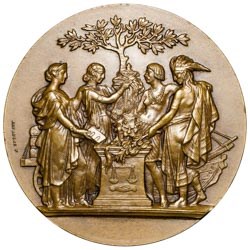 |
 |
| H-30-280: The obverse features an allegorical group of four females, symbolizing the diversity of nations participating in the fair. The medal is 50.5 mm. Click images to enlarge |
|
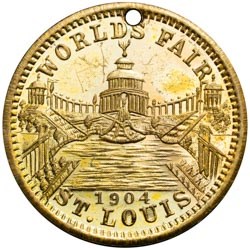 |
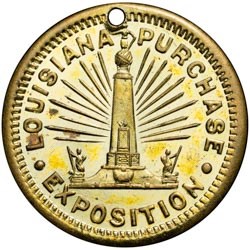 |
| H-61-500: A 21 mm medal featuring Festival Hall, the Cascades and the Louisiana Purchase Monument on the reverse. Click images to enlarge |
|
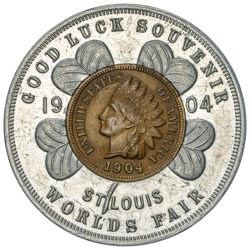 |
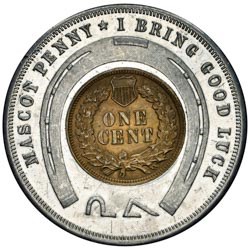 |
| H-14-50: “Good luck” encased cents were popular souvenirs, and were intended to be carried as pocket pieces. Click images to enlarge |
|
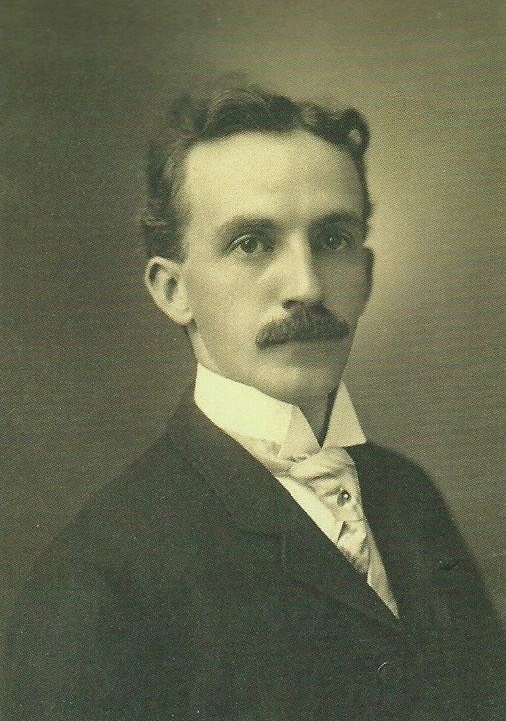 |
|
| Farran Zerbe, pictured here in 1905 as Vice-President of the ANA. He was 34. |
|
An important person at the fair distributing coins and medals was a man named Farran Zerbe. Zerbe was an early rare coin dealer and supporter of the American Numismatic Association, and earned a reputation among fellow coin enthusiasts as a huckster. His flamboyant personality and shameless self-promotion irritated many fellow numismatists who refused to take him seriously. He ferociously promoted the commemorative gold dollar coins featuring Jefferson and President McKinley by distributing anonymous articles about them, without revealing that he was appointed as the Mint’s Director of Exposition coin and medal sales. Despite poor sales at $2 each, and later $2.50 he then raised the price to $3 a piece, claiming they were nearly sold out. This was back when the idea of paying more than face value for a commemorative coin seemed ridiculous, even in the eyes of serious collectors.
Zerbe also ran an exhibit titled “Moneys of the World” through which he tried to bolster interest in collecting coins, the ANA and… his own reputation. Disputes would later surface between Zerbe and collectors who had loaned coins for his exhibit and didn’t receive them back. However, to his credit, Zerbe was also well-studied, and sought to share his vast knowledge of numismatics with fairgoers and spread enthusiasm for the hobby. He issued a medal advertising his prices paid for rare coins in fine condition, which make collectors gawk today. A 1794 $1 is listed at $100, and the famed 1804 $1 is listed at $1,500, while a 1794 50c was listed at only $3!
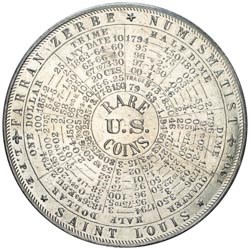 |
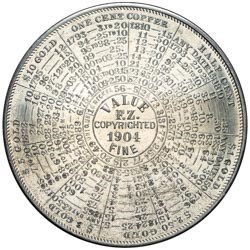 |
| H-61-340: This 51 mm medal was distributed by Zerbe at the fair. It displays the prices he was offering for rare coins. The well-preserved specimen above graded NGC MS 63 PL. Click images to enlarge |
|
Zerbe also produced small gold medalets of his own featuring a fleur-de-lis on the obverse, with “1/2” and “¼” below “Louisiana Gold” on the reverse. While he never claimed these were coins, he did promote them as containing “metal mined in the Louisiana Territory”. This angered some prominent numismatists like Thomas L. Elder who called them a “fraud upon the public.” Elder and Zerbe shared a rocky lifelong friendship, united by their mutual love and dedication to the hobby.
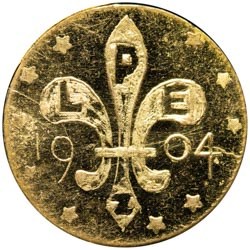 |
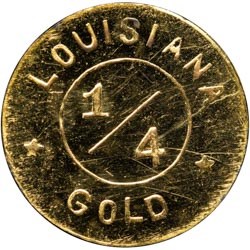 |
| H-61-310: One of Zerbe’s 9.5 mm gold medalets, which often display deep proof-like surfaces. They are extremely thin, and often turn up bent today. Click images to enlarge |
|
Impressively, the Louisiana Purchase Exposition was the only fair in the Victorian era that actually turned a profit. Today, only photographs, souvenirs and a few buildings remain from the event. The beautiful fountains and iconic Cascades were demolished. The 265-foot-high Farris Wheel and it’s 36 cars (which could hold 60 people each), was blown up with 200 pounds of dynamite. Its enormous 45-foot axel was supposedly buried beneath what is now a golf course in Forrest Park, and historians are still searching for it. Nearly all of the wooden buildings were taken down and salvaged, except for the Palace of Fine Arts in which became the Saint Louis Art Museum. A mile away, people can revel in the past glories through the extensive (and free) exhibit “1904 World’s Fair: Looking Back at Looking Forward” in the Missouri History Museum near Forest Park.
The fair left a legacy not of American ingenuity and economics as the previous fairs had, but educated the attendees about what had become American culture, comparing it with those around the globe. One source claims that the fair was so comprehensive, that if every culture of the world had somehow been destroyed in a moment, that they could have been reconstructed from the vast amount of materials and education at the fair. But the fair also highlighted the superiority of western and Anglo-Saxon civilization, through its presentations, exhibits and the 1904 Olympic games held there. And most of all, it demonstrated in a grand way, America’s progress over the century since the Louisiana purchase.
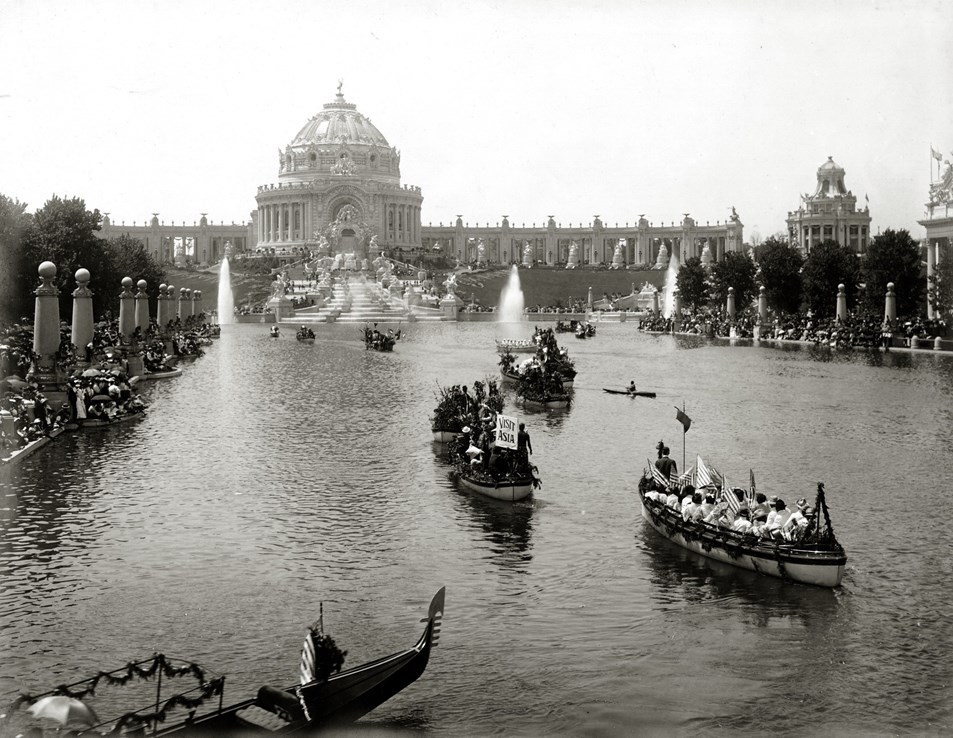 |
|
|
A floral parade of all nations procession floating on the Grand Basin in front of the Cascade Gardens and Festival Hall. Click images to enlarge. |
|
Stay Informed
Want news like this delivered to your inbox once a month? Subscribe to the free NGC eNewsletter today!
Add Coin
Join NGC for free to add coins, track your collection and participate in the NGC Registry. Learn more >

